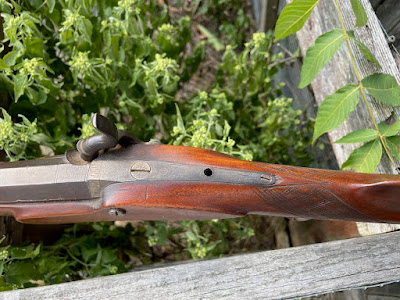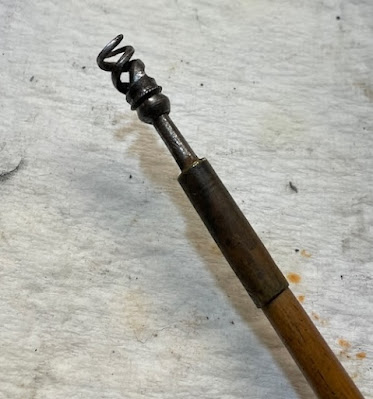I picked up this original 19th Century target rifle via trade yesterday at Dixon's. The asking price was $850.
From what I've been able to determine, J.H. Rector was active in Syracuse 1845 - 1855, and later moved to Buffalo, NY with a partner. My SWAG is that it was built sometime around 1850.
The .40 caliber barrel is 29.5" long and 1" across the flats. It's held to the stock with a single key. It's rifled with 6 grooves although I haven't checked the twist rate yet. The best thing, is that it's in excellent condition. It had some surface rust in the bore which cleaned up nicely with Hoppe's No.9 and elbow grease. There's no significant pitting.It has a hooked breech, but it's not a patent breech. This is an ideal setup IMO. I borescoped it today and this is the breech face. You can see where the flash channel enters the barrel:
The barrel is marked "J.H. Rector Syracuse" with the serial number. It's also marked "Cut by E.G. Davies".
The nipple is .265" x 28 and in good shape but has a larger hole than I'd like. As it turns out Track carries this size as "oversize" nipples, so I ordered a couple.
A closeup of the lock, which is marked "A.T Russel" (only one L):
A sharp eye will see that the hammer nose is damaged, likely from corrosion. I measured its diameter and I may be able to use the neck of a .44-40 case soldered on as repair.
Very clean inside. It's fitted with a fly, although that's not strictly necessary since it doesn't have set triggers.
It holds solid at full and half cock.
The tang is drilled and tapped for a lollipop-style peep sight, which is missing. Once I figure out the thread size I'll look into making a replacement.
All the furniture is iron (tested with a magnet) except for the brass inlays on both sides of the butt.
That small crack at the heel, along with a small chip behind the tang, along with a few dents are the only stock damage.
The business end:
The ramrod appears to be original or a period replacement. The muzzle end is plain but the bottom is fitted with a reversible tow worm.
The gun weighs 9.1 lbs. on my bathroom scale and 46.5" long overall.
For the past few months I've been casually looking for a shootable 19th Century percussion rifle on Gunbroker and Guns International. So, when I saw this on the rack at Dixon's I found it hard to resist.
It's in fantastic shape for a gun that's potentially 175 - 180 years old. I plan to shoot it. Along with the gun I got a bag of .389" balls and have a Lee .390 mold on the way from Track of the Wolf.
Incidentally, if you search for 19th Century percussion rifles you'll find a lot of them that resemble this one. By the last few decades of the century much of the country was settled so this style was developed for target shooting, not taking large game or fighting. Many gunsmiths along the Eastern seaboard were turning out very high quality guns of this type. You can see some of them in Ned Roberts' The Muzzleloading Caplock Rifle, which is pretty much the Bible for percussion rifles.













No comments:
Post a Comment